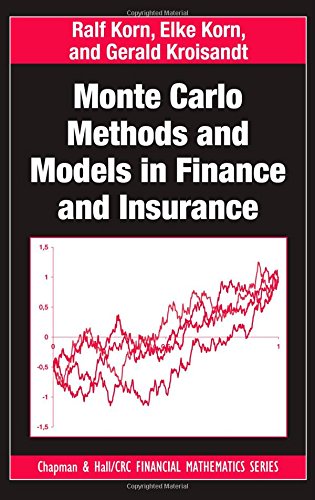Monte Carlo methods and models in finance and insurance ebook download
Par jackson frank le vendredi, juillet 8 2016, 14:31 - Lien permanent
Monte Carlo methods and models in finance and insurance. Korn R.,

Monte.Carlo.methods.and.models.in.finance.and.insurance.pdf
ISBN: 1420076183,9781420076189 | 485 pages | 13 Mb

Monte Carlo methods and models in finance and insurance Korn R.,
Publisher: CRC
In finance it is used to create different models to solve different problem arising from finance such as simulating the stability of the financial system, how much money a company will lose in a given amount of time (VaR) and so on. This is because the “what if” analysis gives equal weight to all scenarios (see quantifying uncertainty in corporate finance), while Monte Carlo method hardly samples in the very low probability regions. This technique has already been used by professionals in fields such as finance, project management, energy, engineering, research and development, insurance, oil & gas, transportation, and the environment. As we know, risk is all about uncertainties. 1149 results found for "Download ebook Monte Carlo methods and models in finance and insurance". Attempting to It's how a MC simulation attempts to contain risk in the controlled environment of a normal curve. Monte Carlo methods are especially useful for simulating systems with many coupled degrees of freedom, such as fluids, disordered materials, strongly coupled solids, and cellular structures (see cellular Potts model). Monte carlo simulation using VB. I'm entertained to think of current Monte Carlo models this way: Monte Carlo is like a bee that swarms in close proximity to a hive and rarely strays too far, or even to another hive. This is a script that adopted from a portfolio optimization template to handle the monte carlo simulation. Learn how to build probability models for asset returns, to apply statistical techniques to evaluate if asset returns are normally distributed, to use Monte Carlo simulation and bootstrapping techniques to evaluate statistical models, and to use optimization methods to construct efficient portfolios. Compare VaR results across SMA VaR, EWMA VaR, Variance co Variance VCV VaR, Historical Simulation VaR and Monte Carlo Simulation VaR. (e.g., annual energy consumption, product lifetime, electricity price, discount rate), DOE conducts the LCC and PBP analysis by modeling both the uncertainty and variability in the inputs using Monte Carlo simulation and probability distributions. Well to be specific, I'm taking the Financial Engineering and Risk Management course offered by Columbia University. Monte Carlo analysis has become an increasingly popular arrow in the financial planner's quiver, as an improvement over. In finance, the Monte Carlo modeling is used to simulate the uncertainty that affects the value of an investment.The idea is to cover all conceivable real world possibilities in proportion to their likelihood. Following this meeting, DOE suspended the issuance of a proposed rule for an energy conservation standard or test procedure until after October 1, 2012 to allow industry representatives and energy efficiency advocates . Statistically, it is the “ probability” of The technique is used by professionals in such widely disparate fields as finance, project management, energy, manufacturing, engineering, research and development, insurance, oil & gas, transportation, and the environment. Since then it has been used in Common users of the Monte Carlo Method in the financial industry can be found in insurance companies where it is used for calculating the risk of the company going insolvent. The alternate approach is based on the techniques documented by Professor Mark Broadie at Columbia Business School as part of his coursework in Security Pricing and Computational Finance courses at Columbia University. On satisfying the requirements, and Microsoft Excel. Monte Carlo simulation performs risk analysis by building models of possible results by substituting a range of values—a probability distribution—for any factor that has inherent uncertainty.